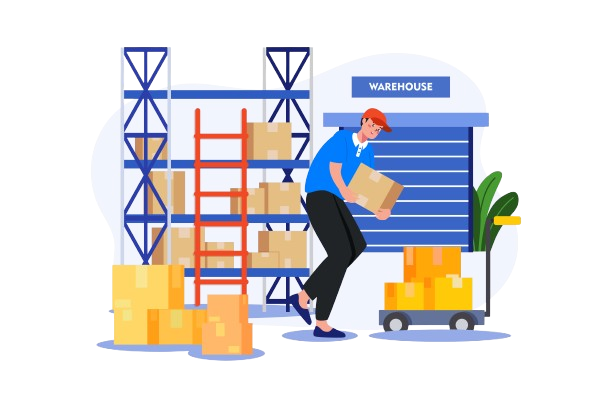Not all heroes wear capes – some wear thermal insulation. Whether it’s strawberries making their way from Spain to Scandinavia or vaccines traveling across continents, temperature-controlled warehouses are the unsung guardians of product integrity. They keep goods at just the right degree of freshness, safety, and compliance.
This guide explores how temperature-controlled warehousing keeps global supply chains stable, the science and technology behind it, and why having a climate controlled warehouse is now a competitive advantage rather than a luxury.
Understanding Temperature Controlled Warehousing

Temperature-controlled warehouses are specialized temperature controlled facilities designed to maintain a consistent temperature range and humidity levels, which are crucial for preserving product integrity. These warehouses are equipped with:
- Advanced refrigeration systems
- Specialized insulation to minimize heat exchange
- Effective monitoring solutions to ensure a consistent temperature range.
The magic of a climate controlled warehouse lies in its ability to shield stored goods from severe temperature extremes. Maintaining a controlled environment is not a luxury but a necessity, especially for temperature-sensitive products. Effective temperature control requires careful temperature monitoring, clear temperature limits, and oversight by specialized staff to ensure everything runs smoothly. Modern warehouses often integrate warehouse mapping systems to maximize efficiency and visibility.
Climate controlled units offer a sanctuary where products remain in prime condition, free from the worries of temperature fluctuations. The investment in such controlled warehousing is justified by the protection it offers to valuable and often irreplaceable goods.
Key Benefits of Temperature Controlled Warehouses
Effective temperature management gives businesses a number of advantages over their competitors. Below are a few reasons why your business might need to implement this technology:
- Extended Shelf Life: Slows product degradation and reduces spoilage. Products stored in a climate controlled warehouse often enjoy a significantly longer shelf life. Brands that sell supplements can especially benefit.
- Regulatory Compliance: Meets strict industry standards for pharmaceuticals and food.
- Waste Reduction: Lowers losses from temperature-related damage.
- Customer Satisfaction: Ensures consistent product quality upon delivery.
- Operational Reliability: Minimizes risks in high-value, temperature-sensitive supply chains.
As businesses scale internationally, many rely on warehousing in Europe to ensure products remain within the correct temperature range during cross-border transport. European temperature-controlled facilities provide advanced logistics networks, fast delivery routes, and compliance with EU safety standards — critical for brands handling perishable or sensitive goods.
Types of Products Requiring Temperature Controlled Storage

Maintaining precise temperatures isn’t just a technical requirement – it’s a matter of product survival and business reputation, especially for certain products. For example, pharmaceuticals lose efficacy when exposed to extreme heat, food products spoil faster when humidity rises, and electronics risk condensation damage without stable air quality. Products that require climate controlled warehouse conditions include:
- Pharmaceuticals & Healthcare: Vaccines, biologics, and medications require strict cold chain conditions to remain effective.
- Food & Beverage: Perishables like meat, seafood, dairy, and produce must be stored at consistent temperatures to prevent spoilage.
- Cosmetics & Beauty: Formulas degrade quickly under heat, so temperature control maintains product stability.
- Electronics & Hardware: Sensitive circuits can warp or corrode without humidity control.
- Fine Art, Documents & Collectibles: Require low-humidity environments to prevent deterioration.
Each category demands unique temperature settings, which is why multi-zone temperature controlled facilities are becoming the logistics standard. Companies that plan German market entry, for example,
or simply expand across Europe must pay extra attention to climate-sensitive storage to maintain product quality.
Fun fact: Humidity-controlled systems can reduce spoilage by up to 30%, especially for perishable goods like fruits, dairy, and medical supplies.
Understanding Multi-Temperature Warehousing

Temperature-controlled warehouses are designed to shield stored goods from severe temperature extremes. Multi-temperature warehouses are a game changer because:
- They support various temperature requirements.
- They enable the storage of diverse products in a single location.
- Each temperature zone within a multi-temperature warehouse is optimized for specific types of products, enhancing their preservation.
The presence of multiple temperature zones ensures that the cold chain remains intact during the storage and transportation of sensitive goods, even in hot and cold extremes. This setup can significantly improve logistics efficiency by allowing for the simultaneous storage of products with different temperatures needs. Insulated building construction and compartmentalized rooms are essential for maintaining varied temperature zones in climate controlled facilities.
Example temperature zones:
- Frozen storage: -18°C to -25°C
- Chilled storage: 0°C to +5°C
- Ambient cool storage: +15°C to +25°C
An ideal climate controlled warehouse integrates seamlessly with the overall supply chain to ensure perishable goods are stored under optimal conditions. This leads to increased customer satisfaction as products retain their quality during storage. Companies implementing ecommerce supply chain management practices can see significant efficiency gains.
Common Tools and Technologies for Temperature Control
Maintaining consistent environmental conditions requires a sophisticated combination of technology and monitoring systems. Climate controlled warehouses rely on integrated tools to ensure that products stay safe and compliant, even in the most demanding conditions.
Monitoring Systems
Environmental sensors, alarms, and data loggers are the backbone of temperature control. They continuously track temperature and humidity levels, alerting staff immediately if conditions deviate from the set range. Real-time monitoring allows for instant corrective action, preventing spoilage or damage to sensitive goods.
Beyond alerts, these systems provide historical data and analytics, helping warehouses understand trends, optimize storage layouts, and anticipate potential risks. This data-driven approach ensures consistent product quality and operational reliability.
Automated Climate Control

Automated temperature and humidity systems maintain stability across every zone of the warehouse. These systems automatically adjust refrigeration, HVAC, and dehumidification in real time to match product requirements.
Key benefits of automation include:
- Precision: Real-time adjustments eliminate manual guesswork and ensure consistent product conditions.
- Efficiency: Smart systems reduce energy use by running only when necessary.
- Compliance: Automated records support audits and help meet strict regulatory standards for food and pharmaceuticals.
By automating these processes, climate controlled warehouses can minimize human error, cut energy waste, and ensure smooth, compliant operations around the clock. Businesses using service level agreements can better guarantee delivery times even for sensitive goods.
Refrigeration Systems
Advanced refrigeration equipment, such as evaporator coils, ammonia piping, and chillers, regulates temperatures throughout large facilities. Properly calibrated refrigeration prevents overcooling or warming, ensuring that frozen, chilled, and ambient products are stored precisely within their required ranges.
These systems work alongside insulation and air circulation to maintain energy efficiency while protecting product integrity.
Energy Optimization Tools
Temperature-controlled warehouses consume significant energy, but modern energy optimization software can reduce operational costs. These platforms coordinate HVAC, refrigeration, and lighting systems, balancing performance with efficiency.
By integrating energy management with climate control and carbon neutral shipping, warehouses lower electricity use without compromising storage quality, contributing to both sustainability and profitability.
The Role of Humidity Control
Temperature alone isn’t enough. Humidity affects product longevity in significant ways. Therefore, humidity control is essential for preventing mold growth and maintaining the quality of stored products.
- Electronics, for example, must be stored in climate-controlled environments to prevent damage from heat and humidity.
- Artwork, particularly oil paintings, requires climate control to avoid deterioration from temperature changes.
- Documents and photographs are also susceptible to fading and moisture damage if not kept in climate-controlled storage.
- Collectibles such as stamps and coins are best stored in climate-controlled settings to avoid damage from humidity fluctuations.
While temperature-controlled warehouses may face challenges in maintaining relative humidity levels, advanced climate control systems can manage humidity in addition to temperature.
How WAPI Helps Businesses Stay Cool (Literally)
This all might sound a little daunting. But here’s the good news: partnering with experts like WAPI for temperature-controlled warehousing solutions takes significant responsibilities off your plate, allowing you to focus on production and sales. WAPI connects businesses with top-tier temperature-controlled fulfillment and storage solutions across Europe, helping brands maintain product quality while optimizing logistics efficiency.
Here’s what sets our approach apart:
- Integrated cold chain management: Seamlessly connect your eCommerce operations with a climate controlled warehouse.
- Real-time tracking: Monitor your stock conditions through smart dashboards.
- Flexible warehousing network: From frozen goods to delicate cosmetics, WAPI matches you with facilities that meet your exact requirements, including on-demand warehousing solutions.
- End-to-end fulfillment: Beyond storage, WAPI handles order processing, packaging, and delivery with strict temperature and humidity compliance.
By choosing WAPI, brands eliminate the need to juggle multiple providers or worry about cold chain interruptions – everything is managed in one streamlined ecosystem.
Energy Consumption and Sustainability

Temperature-controlled warehouses use significantly more electricity compared to ambient warehouses. The following systems contribute to increased energy usage of:
- Air conditioning
- Heating
- Ventilation
- Humidity control
- Refrigeration systems
Sustainability in a Climate Controlled Warehouse
However, modern technologies and sustainable practices are significantly reducing this footprint. Many warehouses now integrate solar panels and renewable energy systems to offset electricity consumption and reduce dependency on non-renewable sources. High-performance insulation and advanced door systems help minimize heat transfer, while LED lighting and motion sensors further cut energy use by optimizing illumination only when needed. A growing number of operators are also switching to natural refrigerants, which lower greenhouse gas emissions compared to conventional cooling agents.
These innovations not only reduce the environmental footprint but also make sound business sense. Energy-efficient warehouses often achieve 20–30% lower operating costs, creating long-term financial advantages and supporting scalable, sustainable logistics for temperature-sensitive goods.
Choosing the Right Climate Controlled Warehouse for Your Needs
Selecting the right climate controlled warehouse means evaluating several key factors that affect both product quality and operational efficiency. Below is a structured breakdown with key points to keep in mind when assessing.
| Evaluation Criteria | What to Look For |
|---|---|
| Product Requirements | Identify the temperature and humidity ranges your goods require. Ensure the facility supports different zones for frozen, chilled, or ambient storage. |
| Location & Accessibility | Choose a warehouse strategically positioned near suppliers, ports, or final customers. Shorter transport routes reduce fuel costs and temperature risks. |
| Technology & Monitoring | Opt for warehouses using real-time tracking, automated alerts, and digital reporting. Visibility over temperature, humidity, and stock movements ensures transparency. |
| Security & Compliance | Confirm that the facility uses CCTV, restricted access, and complies with food, pharma, or cosmetic safety standards relevant to your industry. |
| Scalability & Flexibility | Look for a provider that can quickly adjust capacity during seasonal peaks or unexpected surges in demand. 3PL partners often excel at this. |
| Energy Efficiency & Sustainability | Evaluate insulation quality, cooling systems, and renewable energy use. Green operations not only lower emissions but can reduce energy costs by up to 30%. |
| Cost & Contract Terms | Compare pricing structures, including storage rates, energy usage fees, and minimum volume requirements. Favor contracts that allow flexibility as your business evolves. |
By examining these factors side by side, companies can make informed, data-driven decisions that ensure their temperature-sensitive goods remain protected, efficient to manage, and aligned with long-term logistics goals.
Summary
As global trade expands and customer expectations rise, a climate controlled warehouse has become indispensable for reliable logistics. Such temperature controlled facilities combine precision engineering with advanced monitoring to keep goods secure, compliant, and ready for market.
By choosing the right warehouse partner and leveraging smart climate controlled facilities, businesses can achieve seamless, energy-efficient operations – turning temperature control into a strategic advantage across the entire supply chain.
Frequently Asked Questions
Why is temperature-controlled warehousing important?
Temperature-controlled warehousing is essential for preserving the quality and integrity of temperature-sensitive products, such as pharmaceuticals and fresh produce, by safeguarding them against harmful temperature fluctuations and humidity. This ensures that goods remain safe and effective throughout the supply chain.
What are the key benefits of using temperature-controlled warehouses?
The key benefits of using temperature-controlled warehouses are prolonging product shelf life, reducing spoilage rates, ensuring regulatory compliance, and enhancing reliability in temperature-sensitive supply chains. These advantages are crucial for maintaining product quality and operational efficiency.
What technologies are used in temperature-controlled warehouses?
Temperature-controlled warehouses utilize environmental monitoring systems, automated sensors for temperature and humidity, real-time data logging, advanced refrigeration systems, and humidity control systems to ensure optimal conditions. These technologies work together to maintain quality and safety in stored products.
How do multi-temperature zones work in controlled warehousing?
Multi-temperature zones in controlled warehousing allow for the simultaneous storage of various products by maintaining specific temperatures tailored to the needs of each product. This optimization not only preserves the integrity of the items but also ensures the cold chain is maintained throughout storage and transportation.
How can businesses choose the right temperature-controlled warehouse?
To choose the right temperature-controlled warehouse, businesses must evaluate the types of products stored, supply chain dynamics, customer requirements, and security features. Collaborating with third-party logistics providers can provide scalable solutions that accommodate seasonal demand variations.



 Community
Community
